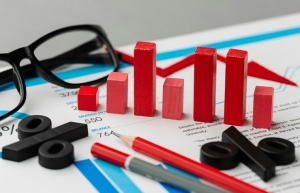Loan interest rates move slower than deposit rates
What is your view on market concerns that local banks increases in deposit rates will lead to higher interest rates?
 |
| Tran Ngoc Bau, CEO of WiGroup Data and Financial Technology JSC |
The increase in deposit rates is not surprising to experts and had been forecasted 3–6 months in advance. Several factors have contributed to the recent rise in deposit rates.
Firstly, the intent of regulators, though not explicitly stated, is evident through their actions. They do not want deposit rates to remain too low, but prefer a slightly higher baseline rate. This rate should be low enough to support economic recovery, but high enough to avoid excessive pressure on exchange rates.
Next, the State Bank of Vietnam (SBV) has sold USD in recent months to reduce exchange rate pressure, which has withdrawn approximately $5.21 billion from the banking system, with no corresponding replenishment. Liquidity injections in the open market are short-term measures, unlike the long-term impact of selling USD.
Although credit growth was slow in the first half of the year, deposit growth was even slower. This has widened the credit-deposit gap, increasing banks’ demand for deposits. Banks are lending more than they are mobilising from deposits, making deposit rates more sensitive to fluctuations in lending and capital mobilisation.
Lastly, the positive aspect is that Vietnam’s economy recovered well in Q2. This recovery has boosted credit demand over the past three months. According to the Vietnam Banking Association, credit growth had risen from minus 2.5 per cent at the end of February to 2.41 per cent by the end of May. If these figures are accurate, credit has surged significantly in just three months, inevitably putting pressure on interest rates.
If banks increase interest rates, what impacts will this have on banks and businesses?
Raising interest rates is appropriate as it ensures banks maintain their net interest margin (NIM), a necessary buffer given the complex bad debt situation. However, interest rates will likely rise more slowly than deposit rates, putting pressure on the NIM throughout the system.
As for the current account savings account ratio, I expect it to remain steady, around 19-20 per cent in the coming quarters. This ratio will be influenced by two factors: the nation’s economic recovery will push it up, but rising interest rates will increase the attraction of term deposits. Balancing these factors is challenging, but I believe they will even out.
For businesses, higher interest rates have mixed implications. On the positive side, the increase in both deposit and interest rates indicates a recovering economy with less pressure on business outputs. The downside is the higher cost of borrowing for businesses.
I am more optimistic. Banks and businesses need not worry excessively, as deposit and interest rates are expected to rise only modestly from the recent lows. I estimate that deposit rates will increase by about 0.5-1 per cent by year-end and then stabilise or decrease next year.
Prolonged low rates can lead to complex consequences for businesses, banks, and the economy. Despite uncertainties, our economy has shown positive recovery signs in recent months.
Is there a solution to keep interest rates stable despite rising deposit rates to support businesses and stimulate economic growth?
Ideally, unless absolutely necessary, we should let the market determine appropriate interest rates. Money, like any commodity, will have its price balanced by supply and demand. Regulatory intervention can influence this balance, but unnecessary interference might complicate matters.
The most difficult challenge for Vietnamese businesses now is their output, followed by access to capital, and then interest rates. During economic recovery, we rely heavily on certain leading healthy enterprises. However, the stronger the enterprise, the less it depends on credit and loans for survival.
The best solution now is to continue opening capital channels for businesses to access multiple sources. Ensuring macroeconomic stability, monetary policy, and exchange rates will help both banks and businesses plan more accurately.
Regulatory bodies and media should actively communicate that the interest rate increase is temporary. Pressuring banks to keep interest rates unchanged could slow lending and distort market mechanisms.
With an increase in deposit rates, will interest rates follow, and what will be the lag time?
It is inevitable that interest rates will rise as deposit rates establish a new higher baseline. The improved economic activity will also position banks more proactively. However, the increase will not be significant, as deposit rates are expected to rise modestly, and regulators will use necessary tools to moderate interest rate hikes.
The lag between deposit and interest rate increases varies, sometimes a few months, sometimes up to a year. It depends on current bank liquidity, capital supply-demand mismatches, and regulatory policy timelines. Given the current context, I anticipate a lag of about two to three months.
Regarding the interest rate forecast for this year, I expect deposit rates to rise by 0.5-1 per cent by year-end and then stabilise or decrease next year.
Consequently, interest rates will slightly expand, closely following deposit rate changes.
 | Interest rates likely to remain fairly levelled Encouraging credit expansion amid declining interest rates is crucial, but maintaining stringent standards is imperative to prevent a resurgence of non-performing loans. |
 | US Fed vice chair says interest rates should remain on pause The US central bank should keep interest rates at their current "restrictive" levels until it sees real progress in the fight to lower inflation, a senior Fed official said Monday. |
What the stars mean:
★ Poor ★ ★ Promising ★★★ Good ★★★★ Very good ★★★★★ Exceptional
Related Contents
Latest News
More News
- Banks gear up for massive capital increases (December 18, 2025 | 17:04)
- Securing capital and efficiency for Vietnam’s 2026-2030 growth ambitions (December 17, 2025 | 10:00)
- Energy sector in need of blended finance mechanisms (December 17, 2025 | 09:00)
- Vietnam still has room to mobilise capital for sustainable growth (December 17, 2025 | 08:57)
- Long-term capital seen as key hurdle to green growth (December 16, 2025 | 08:00)
- Gold prices swing amid tax debate and import uncertainty (December 15, 2025 | 18:04)
- Agribank frames bank credit as catalyst for green growth (December 15, 2025 | 17:59)
- Vietnam’s green transition demands collective financial action (December 15, 2025 | 12:00)
- VIR workshop highlights capital and policy for sustainable development (December 15, 2025 | 11:00)
- Promoting digital assets initiative in Vietnam (December 13, 2025 | 09:30)

 Tag:
Tag:






















 Mobile Version
Mobile Version